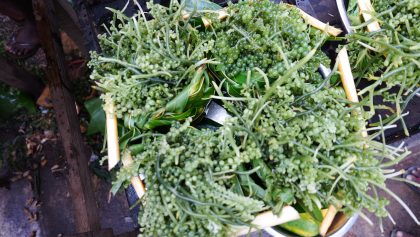Three stalls, three stories – Gizo Market
Gizo Market in the Western Province is always a colourful place.
Market sellers even come from other provinces, such as Guadalcanal and Malaita, just to sell their produce.
Despite the varieties of colourful produces available at Gizo, some things do stand out.
So what are they? SIBC had a look around.
Christina Hillary -Ununusu seller
There are forty of them on a mid-rib if you care to count them all. And they are said to be abundant outside the islands of Gizo.
They are locally known as ‘ununusu’.
Christina Hillary sells trays of them, all baked with coconut milk.
“I got them from outside Logha Island, just across there,” she said, pointing to the island just opposite Gizo Town.
“So what we do is we take the shells home and boil them with water in a big pot.
“They are very easy to pick out once they are boiled, because they have a little ‘finger’ that you can pull out the meat with.
The market women usually bake the ones they sell with coconut milk.
“What we do is wash them clean with water. Then we string them with a mid-rib broom.
“Then we boil the coconut milk in a separate pot and pour the coconut milk on top of the meat. Then we bake them in a hot oven.”
The shells are usually eaten with potato. But just eating them as they are is also best!
One string of shells costs around $5.
Obe Buka : Fisherman
Gizo is well known for its very cheap and fresh fish. And rightly so! Every afternoon the fishermen come ashore to sell their catch of the day at the stalls.
Most of them are caught just outside Gizo. Obe Buka, from Ranogga Island, is one of the fishermen.
“I come here everyday to sell my fish,” he said. “Last night I caught some fish just outside Kennedy Island.
“I usually go out to fish at 9pm in my canoe.”
On a good day – or night rather – Mr Buka can catch up to fifty or sixty fish.
“On bad days, like last night, I only catch 10.
The price varies depending on the size and the quantity of fish caught by all the fishermen.
“Usually I cost my fish around $15 to $60,” he said.
It would only be just a few hours before all the fish are gone.
“I never go back home with my fish. Everyone buys the fish. People who come from Honiara like to eat fish. They always pay so nothing goes back.”
Malbreen Daisy – Seaweed Seller
It is green and slippery to the tongue, but it is considered a great delicacy.
It known as sea weed or ‘Ime’.
Gizo has a seaweed stall open from Monday to Friday.
Malbreen Daisy who lives in Saeraghi, is one of the sellers.
“The seaweed is everywhere, in the mangrove, on the sand, on the stones,” she said.
The seaweed is quite delicate, but the women know how to preserve them so they remain fresh.
“We wrap them in kakake leaves to keep them fresh. If we do not finish our sale, we take them back and hang them in the sea.”
The next day they take the seaweed back out of the water, wash it and bring it to the market.
Looking fresh and green, the seaweeds stand out in the market place.
“There are actually four different types of seaweed in my stall,” Ms Daisy said.
“The soft ones are very nice with chilli tuna. Eating them with cooked ripe banana is also best!”
A lot of the people who came from the surrounding communities would eat the seaweed with cooked fish.
The seaweed is so popular, they even fly them to Honiara to be sold.
“Yes, people would send them to Honiara from here to be sold. They sell them at the Fishing village market in Honiara.”
By Kikiva Tuni






